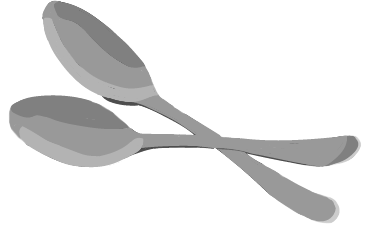Silent Struggle
A look into the struggle of chronic illness

Photo: Claire Rooney
People with chronic illnesses created a supportive community for each other called the “spoonie community.” It was named for Christine Miserandino’s spoon theory.
One morning in Aug. 2016 I woke up unable to move. I was completely paralyzed. It almost didn’t surprise me. Over the past year, doctors had discussed diagnosing me with leukemia, lymphoma, neuroendocrine tumors, multiple sclerosis, Lyme disease and West Nile Virus, to name a few. At that point, I was almost numb.
I had been relatively healthy up until the beginning of eighth grade. I could count the doctors I had seen on one hand. I had no clue that I would see more than 40 doctors over the next three years. All of a sudden I was sick, and no one knew why. Since then, I’ve gone from being ignorant to being painfully aware about illnesses, visible and invisible.
***
Most people aren’t especially educated when it comes to chronic illnesses. I wasn’t. But a study done by the CDC in 2018 showed that at least six in 10 adults in America have at least one chronic illness.
Mrs. Emily Brown, the mother of two St. George’s students, knows all too well the toll chronic illness can take on everyday life. She has been dealing with many complex, chronic diseases including dysautonomia and chronic epstein barr since 2006. For her, seemingly simple tasks require more energy than she has.
“As much as I know people hate going to the grocery store…I can’t go to the grocery,” Mrs. Brown said. “I have to order all of my groceries online. I can barely pick them up and put them in my car. What I would do to be able to walk through a store and pick something out. It’s just the little things. Things that are chores for other people are things that I would pay money to be able to do.”
It’s not only adults that deal with chronic illnesses. Stella Tiesman is a 13-year-old girl who has six chronic illnesses including dysautonomia, Ehlers Danlos syndrome and mast cell activation syndrome. She has to use mobility aids and a feeding tube. Because of this, she often is unable to complete physically demanding tasks. If she overworks herself, she is left debilitated.
“I definitely get very tired, and my symptoms worsen,” Tiesman said. “Basically, I have to then take a huge nap and am in a lot of pain. I can often trigger some anaphylactic reaction because I just wanted to push myself and try to be more independent. I often have to use my wheelchair if I pushed myself too far. Then, it’s too tiring and too much to walk.”
Another study conducted by the CDC in 2012 revealed that 40 million Americans are limited in their usual activities due to one or more chronic health conditions. By those numbers, it’s likely that we all know someone that deals with a chronic illness, but you may not know because many chronic illnesses and disabilities are invisible.
An invisible disability or illness is a condition that is not immediately apparent to someone looking from the outside. Some examples of invisible disabilities are chronic fatigue syndrome, Crohn’s disease, diabetes, epilepsy, fibromyalgia, lupus and migraines.
It’s difficult for people to understand chronic illnesses, especially since they aren’t visible.
“That’s one of the hardest things about being chronically ill when you can’t see it,” Mrs. Brown said. “You don’t have a sign on your face that says ‘I’m super sick,’ so a lot of times you look fine.”
While there were times in my own struggle with chronic illness where my symptoms were obvious – it’s hard to ignore a wheelchair and a bald head – the majority of the time, my illness was, and is, invisible. There are ways in which it is almost easier to be visibly ill than it is to be invisibly ill because it’s much easier to sympathize with something when there is tangible evidence. It’s hard to understand what you can’t see, which leaves many people struggling in silence.
Mrs. Amy Colton, junior Allison Evans’ aunt, had her life turned upside down in 2004. She went from having a good life as a successful attorney to having to fight chronic Lyme disease.
Chronic Lyme disease brings an array of symptoms such as headache, fever, chronic pain and fatigue; U.S. National Library of Medicine National Institutes of Health (NIH) sponsored studies in 2006 that revealed that patient’s quality of life was equivalent to those with congestive heart failure. “People like control and things to categorize neatly into boxes,” Mrs. Colton said. “Chronic illness is not something you can just put neatly in a box.”
Like many chronic diseases, symptoms of chronic Lyme disease, may come and go, often leaving loved ones at a loss for what to do.
“Even your own family can struggle with not understanding that; they want you to be able to go somewhere, do something, and sometimes you’re just not physically able,” Mrs. Colton said. “I think the erratic nature of it – the highs and lows, the being able to be there sometimes and sometimes not – is something that, because human beings like definition and control, they have a problem with it.”
***
For those with chronic illness, the diagnosis can feel like a life sentence. And for those on the outside, it is hard to grasp the “chronic” in “chronic illness.”
While I was in the hospital, visibly ill, people would send me lots of “get well” cards. They’d have encouraging words or pictures of flowers or cute animals that would make me smile, but seeing the words “get well soon” was painful. I appreciated the sentiment and knew each card came from a place of love, but seeing those words in writing would just re-emphasize the chronic part of my diagnosis. I wasn’t going to get well soon. I wasn’t ever going to get well. My life was forever changed. Thankfully, I currently am able to treat many of the symptoms my chronic illnesses bring by getting IV infusions three times a week as well as other forms of treatment, but I am not able to be cured of these diseases.
There were outpourings of sympathy when I was first paralyzed, but as my illness receded into invisibility, people also started to back away. I don’t think it’s because they didn’t care, but because they didn’t know what to do. When you see someone in a wheelchair, you know you can help by clearing a path for them, but when you see someone who looks deceivingly healthy, it’s difficult to know how to respond. The world doesn’t offer a lot of guidance on how to handle chronic, invisible illnesses.
“I think the biggest issue is that movies, books and TV will show that people will send you flowers and support you and come to see you and write to you and all of those things,” Mrs. Colton said. “It’s in fact the opposite. Most people ignore you, don’t come to see you. It’s profoundly lonely and isolating. I think that’s an injustice that the entertainment industry does to people because it sets up that expectation of, ‘Someone’s going to care,’ and quite honestly if you have one or two friends or even just one friend that sticks by you, you’re really lucky.”
Chronic illness does not only affect the physical body but also can take a toll emotionally. A study done by the NIH in 2018 revealed the negative impact that a patient’s chronic disease had on quality of their social life.
“I’ve had a lot of friends that have bailed,” Mrs. Brown said. “At the time, it kind of felt that they didn’t believe me or they didn’t care, but I think it’s really just that in their minds they think that it’s all that we talk about. I think that they just didn’t understand and can’t understand that it is my life.”
Tiesman agreed that relationships can be a challenge when you suffer from a chronic illness.
“Definitely that a lot of people with chronic illness need support and for you to validate what they are feeling,” Tiesman said. “I feel like not a lot of people do that or you have a friend and someone gets a chronic illness and they basically up and abandon you. You just really need a lot of support or just for somebody to be there for you even if you don’t fully understand. Also, it is always okay to ask questions. It’s better to ask questions if you don’t understand than just assume things.”
Not only do friends not always understand, but doctors don’t always understand either.
“Because common things are common and uncommon things are uncommon [it takes longer to diagnose],” Dr. A. Earl Weeks, a medical oncologist and hematologist at West Cancer Center, said. “Usually it’s easy to find bad things. Subtle things don’t usually present with as many definable issues. You just don’t think about them as much.”
While invisible disabilities and illnesses are common, they are often underdiagnosed or take a long time to diagnose because they are hard to understand. According to a 2011 study published in BioMed Central Health Services Research, it takes an average of over two years to get a diagnosis for fibromyalgia, and it takes an average of five years to get a diagnosis for dysautonomia according to a 2013 study by Dysautonomia International.
“It’s definitely not easy because people don’t want to take you seriously because you are so young,” Tiesman said. “It’s hard going to doctor’s offices and talking to a doctor who is of course much older than me, and trying to get him to understand how I feel. Because I am so young, they do want to relate a lot of my problems to me being a hormonal teenager and wanting to get attention.”
Mrs. Colton’s diagnosis of Lyme disease also took a long time to receive. Lyme disease takes particularly long to diagnose because tests are often inaccurate which leaves the patient with debilitating symptoms and no answers.
“I started to have all those debilitating symptoms of severe fatigue, pain, disorientation, memory loss, confusion, all of that,” Mrs. Colton said. “It took about a year for me to get diagnosed with Lyme Disease. I had to go to the Northeast because a lot of the doctors in the South dismissed my symptoms and made me feel like I was crazy or seeking attention or told me that there was no possible way that you could contract Lyme Disease in the South even though the Center for Disease Control had documented cases of it from Tennessee.”
Doctors can often misinterpret symptoms and have trouble diagnosing lesser known, complex illnesses.
Autoimmune diseases and hematologic disorders are particularly difficult for doctors to understand and diagnose because of lack of awareness.
“You don’t really hear much about it,” Dr. Weeks said. “It’s sort of one of these silent problems. It’s not that nobody wants to talk about it, it’s that nobody knows to talk about it.”
***
Because it isn’t commonly talked about in society, people who have these illnesses and disabilities have created a supportive community for each other called the “spoonie community.” It was named for Christine Miserandino’s spoon theory in which people who have chronic illnesses have a certain amount of spoons per day that they are allotted to use. Simple tasks such as brushing your teeth and getting out of bed take spoons, and everything has to be budgeted with these “spoons.” Many people with chronic illnesses have adopted this analogy, nearly as convoluted as the illness themselves, in order to explain what they go through.
“All of a sudden put a price on every single thing that you have to do,” Mrs. Brown explained. “From brushing your teeth to taking a bath to doing a load of dishes or making dinner for your family or buying groceries, when every single one of those things – like you just said ‘okay this is how much money you have to spend today’ and all of those things cost money, you can’t go over budget. Or say you can go over budget but that means you have less tomorrow.”
I met a number of people through this spoonie community including Tiesman. Managing all of her illnesses has left her unable to attend school, so she relies on the spoonie community in order to interact with people like her.
“It can definitely help when needing support and meeting people who understand what I’m going through because most people around me right now don’t. So it’s a great way to get support and make new friends.”
Tiesman doesn’t live a normal teenage life because she spends most of her life at doctor’s visits and trying to manage her symptoms. She may be seen as different because of this routine, but she still wants to be considered a normal teenager.
“Chronic illness does not define who I am,” Tiesman said. “It is something that I manage, but it is not me as a person.”
That’s maybe the the most important lesson I’ve learned through my journey. A person that has a chronic illness is just that: a human that happens to be sick. Yes, the symptoms may take over your life, and at times it may seem like your illness is your identifier. As someone from the outside, it’s easy to be overwhelmed when a loved one is dealing with chronic illness and then fall into the trap of letting them be defined by their illness.
As Mrs. Colton said, “Most people with chronic illness are incredibly tough and survivors. So if you see someone with a chronic illness, you should see them in terms of their strength and not in terms of weakness.”











Robynn Holladay • Apr 25, 2019 at 12:11 AM
A wonderful piece on life with chronic illness through the eyes of a young person. My 17 year old daughter with multiple chronic illnesses would find this information validating and accurate. It is hard to accept when young people are terribly ill with incurable diseases. If more articles like this one were published it might bring attention to the problem of a growing population of teens suffering from chronic illness without being believed and efficiently helped because they are young and appear healthy.